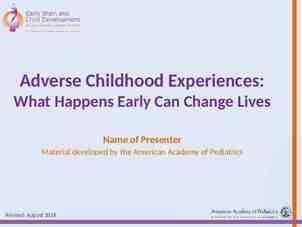CHRONIC ILLNESS AND AGING
24 Slides42.00 KB
CHRONIC ILLNESS AND AGING
CHRONIC ILLNESS: A long-lasting illness (in contrast to ACUTE illness, which is temporary) Most common in older adults – – – Heart disease Cancer Cerebrovascular disease (stroke)
HEART DISEASE: Principal cause of death among o.a.’s Accounts for significant morbidity, disablement & inactivity among o.a.’s Dominant factor--atherosclerosis (build-up of fatty deposits within arterial walls)
Mechanism: Atherosclerotic buildup------ Narrowing of arteries supplying blood to the heart----- ISCHEMIA (denial of adequate blood supply)
Ischemic heart disease also known as: – – – – coronary heart disease (CHD) coronary artery disease A common form: myocardial infarction (heart attack) persistence of deficient blood supply, tissue dies. Dead area: an infarct
Heart attack may also result from: Cardiac arrest-- some interruption of normal pattern of cardiac contraction Coronary thrombosis--sudden blockage of coronary artery with a blood clot Strenuous exercise resulting in suddenly increased need for O2
Mortality associated with MI: Over 70--2x that under age 70 Symptoms of MI may differ in older people than in younger ones
“ while complete absence of chest pain is very rare in acute myocardial infarction up to middle age, it is a ‘mundane occurrence’ in old people” “ only about 1/3 of elderly patients present with a classical prolonged episode of chest pain”. (Kart & Kinney, p. 111)
Heart Disease: Modifiable Risk Factors: Cigarette smokers 2x MI rate of non-smokers High BP High serum cholesterol levels Diabetes Obesity Sedentary lifestyle
Healthy People 2000 goals: 1. Increase prop. Of people whose high BP is under control 2. Reduce mean-serum cholesterol levels 3. Reduce dietary fat intake & average unsaturated fat intake 4. Reduce prevalence rates of obese/oveweight adults
5. Increase proportion of children & adults engaging in regular, daily physical activity at least 30 min/day 6. Reduce cigarette smoking among people age 20 and older http://www.health.gov/healthypeople
CANCER 2nd leading cause of death in U.S. Incidence increases with age--Why? – – Most forms of cancer have a long latent period; initiating factors start during youth increasing age and accompanying physiological changes make one more susceptible to actions of carcinogens
CA, cont’d onset and management of many cancers do not vary greatly in the old and young. Prevention is still the order of the day regarding cancer.” p. 113. This includes:
1. Avoiding unnecessary exposure to ionizing & ultraviolet radiation 2. Implementing hygienic measures in occupations involving exposure to CA-producing chemicals & dusts 3. Avoiding exposure to tobacco & cigarette smoke 4. Have periodic preventive medical exams.
CEREBROVASCULAR DISEASE Results from: – – – changes in blood vessels that serve the brain tissue cerebral infarction cerebral hemorrhage
When a portion of the brain is completely denied blood, a cerebrovascular accident (CVA), or stroke results Severity is determined by location and total amount of brain tissue involved
After diseases of the heart, malignant neoplasms, & accidents, cerebrovascular disease is the fourthleading cause of death in the U.S.
Cerbral Thrombosis Main cause of stroke in o.a.’s Occurs when a formed clot becomes lodges in an already narrowed artery.
Stroke in evolution: – – May develop over hours or even days Symptoms can appear within minutes or hours after onset
Transient ischemic attacks (TIA’S)--”ministrokes” Warning signs of an impending stroke Transitory symptoms: – – – – – sudden motor weakness speech dysfunction dizziness sudden changes in vision (especially in one eye) sudden falls
Cerbral Embolism: Another cause of strokes Thrombus forms elsewhere in the body and travels to obstruct a vessel supplying the brain The onset of the stroke and its damage is immediate
Damage from Strokes One-sided weakness or paralysis Sensory disturbances Aphasia (speech disorders) Mental symptoms Rehab should begin immediately
APHASIA Impaired ability to comprehend or express verbal language Receptive aphasia: – – – difficulty in processing external stimuli; may not understand other’s speech or what is read familiar objects may become unrecognizable
Expressive aphasia – A person understands what is said but cannot form the words or gestures to respond to stimuli – May be incorrectly associated with mental deterioration





























